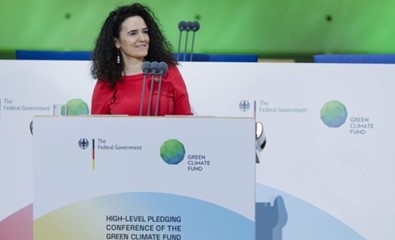
Green Climate Fund Revamps to Become Top Donor Partner
Mafalda Duarte, the head of the Green Climate Fund (GCF), outlines her strategy to increase the fund's influence and attract more financial support. Since its inception in 2015, GCF has grown its climate investments to $15 billion across 270 projects aimed at reducing emissions and helping developing nations adapt to climate change.
Duarte, a Portuguese climate finance expert, highlights the fund's untapped potential in an exclusive interview. She points to innovative approaches like equity investments supporting entrepreneurs, a green credit guarantee company, and a finance platform for local governments. Duarte acknowledges the need to improve the fund's focus on impact measurement and communication as part of a broader overhaul.
Based in Songdo, South Korea, GCF is streamlining operations to better track its contributions to climate adaptation, enhance partnerships, and increase efficiency in working with organizations deploying its funds on the ground. Currently, the fund works with around 250 partners in over 130 countries, primarily in the Global South.
Improving Efficiency and Speed
Since its launch a decade ago under the UN climate framework, the GCF has faced criticism for slow processes and high costs, particularly from partners in poorer countries. Duarte is addressing these issues, cutting the time for project fund disbursement from an average of 14 months in 2022 to just 4.5 months. Recently, GCF set a new record, delivering funds for projects in Bhutan and Malawi just 15 days after approval.
Duarte is focused on reducing the approval process for new projects to nine months, down from two years, by 2025. This effort is a key part of her "50 by 30" vision to manage $50 billion by 2030. With $33.1 billion in pledges since 2014, GCF has received $18.5 billion to date.
New Vision for Climate Finance
Duarte's vision includes increased support for vulnerable countries, deeper private sector engagement, and shifting from individual projects to broader, program-based initiatives. Under previous leadership, the GCF struggled with internal issues, but now, after reforms, it aims to maximize its impact in local communities.
To further this mission, the fund is reorganizing its 300 employees into regional teams that will focus on delivering integrated services from project design to implementation. Duarte is also working on strategies to secure funding from private philanthropies and through innovative mechanisms such as new global climate taxes.
Navigating Global Politics
As the GCF heads into its second replenishment cycle, Duarte acknowledges political challenges, particularly in securing the United States' full contribution of $3 billion. The outcome of the 2024 US election could impact future pledges, especially given past resistance from Republican leaders. Duarte stresses the importance of preparing for any shifts in donor priorities and making a stronger case for climate finance as a critical investment for the future.
The GCF estimates its projects will make 1 billion people more resilient to climate change while preventing emissions equivalent to 3 billion tons of CO2.